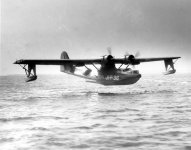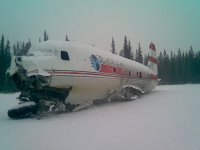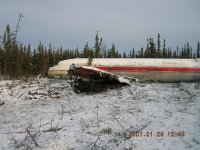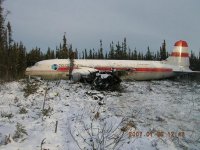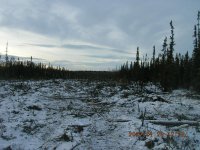Wow.
http://www.edmontonjournal.com/news/brightside/farmers+save+Canso+plane/2504912/story.html
Can-do farmers save Canso plane
Northern rescue mission brings vintage aircraft safely to Fairview
BY KEITH GEREIN, EDMONTON JOURNALJANUARY 31, 2010

The Canso vintage airplane marooned by a frozen Arctic lake gets a tow across the tundra.
At first glance, the assignment must have seemed like something out of a Mission Impossible movie, but one even Tom Cruise would refuse to take on: Trek into the wilderness north of the Arctic Circle, retrieve a broken plane marooned on the edge of a remote, frozen lake, and find a way to drag it out of the bush some 2,500 kilometres back to civilization.
Oh, and do it in early spring when temperatures are still hovering around -40 C.
Sound like a fool's errand?
Not to Don Wieben, a vintage airplane enthusiast who has restored a number of older aircraft and flown them around Canada.
For this project, his prize was an abandoned Canso -- an amphibious plane built during the Second World War to hunt submarines and protect convoys crossing the Atlantic. Just a handful of the aircraft remain in the skies today, which is why Wieben, a farmer from Fairview, Alta., decided to recruit a group of relatives, friends and neighbours for an elaborate rescue mission.
"The idea was to salvage a significant part of Canadian history," Wieben says. "The Canso served a pretty important role during the war, rescuing sailors and airmen, patrolling for submarines. The Spitfire and the bombers got all the glory, but the Canso quietly went about its job."
Wieben's immersion in aviation started in childhood while he was growing up in Northern Ontario. His father worked as an instructor for the Royal Canadian Air Force, served as a test pilot, then started his own airline in Thunder Bay, transporting cargo to northern aboriginal communities.
Wieben caught the piloting bug early, completing his first solo flight when he was 14.
As a young man he started working for his father's company, hauling freight in the summers when he was off from school. It was during these trips that he met his wife Marg in Sioux Lookout, Ont.
"I grew up with airplanes like people on the Prairies grow up around tractors," he says.
As much as he enjoyed his job, however, the one downside was that it took him away from home too often. With four small children to look after, he decided he needed a more grounded lifestyle and the family moved to northern Alberta in 1972 to try farming.
While the farm succeeded, tilling the soil and tending grain did little to curb Wieben's passion for flying.
Instead of his job, it became his hobby. Each year after the harvest was complete, the family would buy a dilapidated plane and work on it through the winter to restore it to flying condition.
Over the years, the list of aircraft included a number of Super Cubs, a Cessna 185 and an old Beech 18.
Wieben still owns three of the planes, frequently flying them from a small landing strip on the farm.
All of these projects, however, paled in comparison with the Canso.
The adventure started in late 2006. Wieben was in Didsbury visiting his youngest son when they decided to take a visit to the Red Deer airport.
On the tarmac were three Cansos belonging to Buffalo Airways, a company that provides passenger, cargo and other air services primarily in the Northwest Territories. The Cansos were being used as water bombers to fight forest fires.
The caretaker allowed Wieben a closer look at the old planes and told him they were up for sale because the federal government had decided to give the water bombing contracts to newer aircraft. At least two of the Cansos were headed for new owners in the United States.
Wieben knew something of the Cansos' role in the Second World War. He also figured that of the several hundred that had been built in Canada, few were likely still around.
"I thought it was a shame that these historic airplanes were being sold outside the country. I stopped in to see (Buffalo Airways owner) Joe McBryan a little later and I was giving him static about it. I told him he should keep one as a heritage airplane."
McBryan had his own idea. He told Wieben that if he wanted to save a Canso, there was one sitting by itself in the far North.
Canso 11094, as it was known during the war, was built in 1943 and often flew between Canada's east coast and Iceland on submarine hunting patrols.
After the war, it was converted into a water bomber and went through a few owners before Buffalo Airways purchased it for firefighting duty in the Northwest Territories.
The plane's service ended abruptly in 2001. Based in Inuvik, the plane was conducting a training exercise picking up water from nearby Sitidgi Lake when something went wrong. The aircraft dug its nose into the water, damaging the front wheel well and right wing. It sank before the crew could save it.
Deciding it would be too costly to retrieve and repair the plane, the company instead dragged it to the northeast shore so they could remove its valuable equipment, including the engines, propellers and some of the instruments. The rest of the aircraft remained abandoned at the side of the lake.
"I made a deal with McBryan to buy the plane 'as is, where is' for a relatively small amount of money," Wieben says. "That's where it started, and then we had to figure out how we were going to move 15,000 pounds (6,818 kilograms) of Canso out of the bush."
The logistics of the mission soon turned into a planning headache. Just getting the plane to the nearest highway would require pulling it 30 kilometres across the lake, then another 30 kilometres through the snowy tundra. Special permission would be needed to cross the tribal lands of the Gwich'in people, who required the operation leave as small a footprint as possible.
And Wieben knew it all had to be done within a short window of time in early spring -- a part of the year when there was still snow on the ground, but temperatures were mild enough to work in.
Slowly, with the help of some friends and neighbours, an assignment that at first seemed impossible began to move closer to reality.
First to sign up were Joe Gans and Brian Wilson, who set to work welding together a pair of long skis that would fit around the Canso's wheels. Norbert Luken then joined in, along with Henry Dechant and Doug Roy, who used aerial photos to sketch out a route through the tundra.
The skis would allow the plane to slide across the snow, but the group also needed a machine strong enough to pull the plane, yet light enough to avoid damaging the tundra.
For help, Wieben visited a local seismograph services firm, which had a light track machine called a Yanmar. The firm's owner, after hearing Wieben's story about the mission, agreed to loan the vehicle at no charge. It was to be the first of several occasions the group received charity from people they barely knew.
Finally, during the first week of April 2008, Wieben, Gans, Luken and Wilson set out for Inuvik in a pair of one-tonne trucks and trailers carrying all the equipment.
Arriving in the Arctic town 48 hours later, the group used snowmobiles, the Yanmar and the help of a local guide, Albert Frost, to trek out to the plane.
Over the next five or six days, the men camped in Frost's tent beside the aircraft, working in limited daylight and minus-35 C cold to prepare the Canso for its journey.
Once the skis were securely attached, the first part of the moving operation called for the Yanmar to pull the plane across the frozen lake to the south shore.
The machine worked, barely, but progress was agonizingly slow. Carrying such a load, the Yanmar could travel six kilometres per hour. The group had to leave the plane on the lake overnight and come back the next day to finish the trip.
Even more difficult was the next leg of the journey -- traversing 30 kilometres of tundra to the Dempster Highway. No longer on the smooth surface of the lake, the Yanmar struggled in the deep snow. To get anywhere, the men were forced to go ahead with their snowmobiles and pack down the trail.
"After two days we were only halfway across the tundra," Wieben recalls. "It was taking us a lot longer than we expected and we were in a bit of a race. There was a forecast of warm weather coming and we knew we had to be off the tundra before the snow melted."
By that time, Dechant and Roy had flown to Inuvik to help. In town, they contacted a local business owner who agreed to send out a driver with a snowcat, a bigger and more powerful machine than the Yanmar. Such service could have cost up to $10,000, but the owner refused to charge Wieben's crew anything, agreeing instead to take a free ride on the plane if it ever became airworthy.
At 11 p.m. the next day, the plane made it to the highway.
"That was a great moment," Roy says. "It was a celebration to have accomplished that much, even though we knew we had a long way to go."
For the next stage of the journey, the plan was to turn south. The Canso was to be hooked up to a truck that would carefully transport it along 2,500 kilometres of highway to Fairview.
But another business owner from Inuvik -- a man who provided a free satellite phone to Wieben -- had a better idea. He suggested the plane instead be dragged north through Inuvik to the shipyards of the Northern Transportation Company, Ltd.
The man said a friend of his with the transport company would put the plane on a Mackenzie River barge. The barge would drop it off in Hay River, N.W.T., near the Alberta border, saving Wieben's crew days of aggravation on the highway.
Agreeing to this new proposal, the group still had one obstacle to overcome. The trip to the shipyard was via a road that appeared too narrow to handle the aircraft.
The Canso's wingspan was originally 32 metres, but about three metres of the right side had broken off in the 2001 crash. Wieben's crew decided to cut off another three metres that had to be replaced anyway, which shortened the width just enough to get it down the road.
"We made it with about two feet of space to spare between the power poles," Wieben says.
As promised by the barge company, the Canso showed up in Hay River a few months later, in October.
But to tow the plane back to Fairview, Wieben again needed a favour. This time, a trucking company from Grande Prairie came to his aid by loaning him a special double-drop trailer -- a device that ensured the 19-metre-long plane rode low enough to travel underneath highway overpasses.
"We were basically strangers out of the blue, but the co-operation we got from people throughout the trip was just amazing," Wieben says.
After removing the top wing and loading it onto a separate trailer, the two sections of the aircraft were driven south to a welcome in Fairview, where it was put on display last summer for six weeks.
Despite all the work that went into rescuing the plane, Wieben says that was just Phase 1 of a three-part process. The second phase will be to determine if the plane can be restored to flying condition. If so, the plan is to operate it as a heritage airplane and fly it to various air shows around the country. Roy also hopes to take it to small northern communities for short visits, allowing children to learn a little about Canadian aviation history.
So far, the repair process has been daunting. Canso parts are hard to find and expensive, and the group will have to pay for certified engineers to do some of the work. Wieben believes it may cost up to $300,000 to get the plane airborne.
He hopes people will come forward with donations of money, parts or aircraft expertise. The group is also considering selling shares in the plane or applying for heritage and educational grants from the government.
Should the repair process fall short, Wieben says the plane will likely be turned into a static display that people can visit.
"All of us in the group can put some money into it, but none of us are wealthy," he said of the six members of the "Canso Crew," all of whom are in their 60s except for Luken. "We've got it this far, but there's a chance for so much more."
"Whenever I turn on the TV news at night, all I hear is the negative - a killing in Afghanistan, a murder in Vancouver," Wieben says. "But the experience of Canada we had being involved with this Canso is so much different. We met so many great people that helped us achieve our goal.
"And this is just a little story. Six farmers bring a derelict airplane out of the North. And yet it was such a great adventure."
Can-do farmers save Canso plane
Northern rescue mission brings vintage aircraft safely to Fairview
BY KEITH GEREIN, EDMONTON JOURNALJANUARY 31, 2010

The Canso vintage airplane marooned by a frozen Arctic lake gets a tow across the tundra.
At first glance, the assignment must have seemed like something out of a Mission Impossible movie, but one even Tom Cruise would refuse to take on: Trek into the wilderness north of the Arctic Circle, retrieve a broken plane marooned on the edge of a remote, frozen lake, and find a way to drag it out of the bush some 2,500 kilometres back to civilization.
Oh, and do it in early spring when temperatures are still hovering around -40 C.
Sound like a fool's errand?
Not to Don Wieben, a vintage airplane enthusiast who has restored a number of older aircraft and flown them around Canada.
For this project, his prize was an abandoned Canso -- an amphibious plane built during the Second World War to hunt submarines and protect convoys crossing the Atlantic. Just a handful of the aircraft remain in the skies today, which is why Wieben, a farmer from Fairview, Alta., decided to recruit a group of relatives, friends and neighbours for an elaborate rescue mission.
"The idea was to salvage a significant part of Canadian history," Wieben says. "The Canso served a pretty important role during the war, rescuing sailors and airmen, patrolling for submarines. The Spitfire and the bombers got all the glory, but the Canso quietly went about its job."
Wieben's immersion in aviation started in childhood while he was growing up in Northern Ontario. His father worked as an instructor for the Royal Canadian Air Force, served as a test pilot, then started his own airline in Thunder Bay, transporting cargo to northern aboriginal communities.
Wieben caught the piloting bug early, completing his first solo flight when he was 14.
As a young man he started working for his father's company, hauling freight in the summers when he was off from school. It was during these trips that he met his wife Marg in Sioux Lookout, Ont.
"I grew up with airplanes like people on the Prairies grow up around tractors," he says.
As much as he enjoyed his job, however, the one downside was that it took him away from home too often. With four small children to look after, he decided he needed a more grounded lifestyle and the family moved to northern Alberta in 1972 to try farming.
While the farm succeeded, tilling the soil and tending grain did little to curb Wieben's passion for flying.
Instead of his job, it became his hobby. Each year after the harvest was complete, the family would buy a dilapidated plane and work on it through the winter to restore it to flying condition.
Over the years, the list of aircraft included a number of Super Cubs, a Cessna 185 and an old Beech 18.
Wieben still owns three of the planes, frequently flying them from a small landing strip on the farm.
All of these projects, however, paled in comparison with the Canso.
The adventure started in late 2006. Wieben was in Didsbury visiting his youngest son when they decided to take a visit to the Red Deer airport.
On the tarmac were three Cansos belonging to Buffalo Airways, a company that provides passenger, cargo and other air services primarily in the Northwest Territories. The Cansos were being used as water bombers to fight forest fires.
The caretaker allowed Wieben a closer look at the old planes and told him they were up for sale because the federal government had decided to give the water bombing contracts to newer aircraft. At least two of the Cansos were headed for new owners in the United States.
Wieben knew something of the Cansos' role in the Second World War. He also figured that of the several hundred that had been built in Canada, few were likely still around.
"I thought it was a shame that these historic airplanes were being sold outside the country. I stopped in to see (Buffalo Airways owner) Joe McBryan a little later and I was giving him static about it. I told him he should keep one as a heritage airplane."
McBryan had his own idea. He told Wieben that if he wanted to save a Canso, there was one sitting by itself in the far North.
Canso 11094, as it was known during the war, was built in 1943 and often flew between Canada's east coast and Iceland on submarine hunting patrols.
After the war, it was converted into a water bomber and went through a few owners before Buffalo Airways purchased it for firefighting duty in the Northwest Territories.
The plane's service ended abruptly in 2001. Based in Inuvik, the plane was conducting a training exercise picking up water from nearby Sitidgi Lake when something went wrong. The aircraft dug its nose into the water, damaging the front wheel well and right wing. It sank before the crew could save it.
Deciding it would be too costly to retrieve and repair the plane, the company instead dragged it to the northeast shore so they could remove its valuable equipment, including the engines, propellers and some of the instruments. The rest of the aircraft remained abandoned at the side of the lake.
"I made a deal with McBryan to buy the plane 'as is, where is' for a relatively small amount of money," Wieben says. "That's where it started, and then we had to figure out how we were going to move 15,000 pounds (6,818 kilograms) of Canso out of the bush."
The logistics of the mission soon turned into a planning headache. Just getting the plane to the nearest highway would require pulling it 30 kilometres across the lake, then another 30 kilometres through the snowy tundra. Special permission would be needed to cross the tribal lands of the Gwich'in people, who required the operation leave as small a footprint as possible.
And Wieben knew it all had to be done within a short window of time in early spring -- a part of the year when there was still snow on the ground, but temperatures were mild enough to work in.
Slowly, with the help of some friends and neighbours, an assignment that at first seemed impossible began to move closer to reality.
First to sign up were Joe Gans and Brian Wilson, who set to work welding together a pair of long skis that would fit around the Canso's wheels. Norbert Luken then joined in, along with Henry Dechant and Doug Roy, who used aerial photos to sketch out a route through the tundra.
The skis would allow the plane to slide across the snow, but the group also needed a machine strong enough to pull the plane, yet light enough to avoid damaging the tundra.
For help, Wieben visited a local seismograph services firm, which had a light track machine called a Yanmar. The firm's owner, after hearing Wieben's story about the mission, agreed to loan the vehicle at no charge. It was to be the first of several occasions the group received charity from people they barely knew.
Finally, during the first week of April 2008, Wieben, Gans, Luken and Wilson set out for Inuvik in a pair of one-tonne trucks and trailers carrying all the equipment.
Arriving in the Arctic town 48 hours later, the group used snowmobiles, the Yanmar and the help of a local guide, Albert Frost, to trek out to the plane.
Over the next five or six days, the men camped in Frost's tent beside the aircraft, working in limited daylight and minus-35 C cold to prepare the Canso for its journey.
Once the skis were securely attached, the first part of the moving operation called for the Yanmar to pull the plane across the frozen lake to the south shore.
The machine worked, barely, but progress was agonizingly slow. Carrying such a load, the Yanmar could travel six kilometres per hour. The group had to leave the plane on the lake overnight and come back the next day to finish the trip.
Even more difficult was the next leg of the journey -- traversing 30 kilometres of tundra to the Dempster Highway. No longer on the smooth surface of the lake, the Yanmar struggled in the deep snow. To get anywhere, the men were forced to go ahead with their snowmobiles and pack down the trail.
"After two days we were only halfway across the tundra," Wieben recalls. "It was taking us a lot longer than we expected and we were in a bit of a race. There was a forecast of warm weather coming and we knew we had to be off the tundra before the snow melted."
By that time, Dechant and Roy had flown to Inuvik to help. In town, they contacted a local business owner who agreed to send out a driver with a snowcat, a bigger and more powerful machine than the Yanmar. Such service could have cost up to $10,000, but the owner refused to charge Wieben's crew anything, agreeing instead to take a free ride on the plane if it ever became airworthy.
At 11 p.m. the next day, the plane made it to the highway.
"That was a great moment," Roy says. "It was a celebration to have accomplished that much, even though we knew we had a long way to go."
For the next stage of the journey, the plan was to turn south. The Canso was to be hooked up to a truck that would carefully transport it along 2,500 kilometres of highway to Fairview.
But another business owner from Inuvik -- a man who provided a free satellite phone to Wieben -- had a better idea. He suggested the plane instead be dragged north through Inuvik to the shipyards of the Northern Transportation Company, Ltd.
The man said a friend of his with the transport company would put the plane on a Mackenzie River barge. The barge would drop it off in Hay River, N.W.T., near the Alberta border, saving Wieben's crew days of aggravation on the highway.
Agreeing to this new proposal, the group still had one obstacle to overcome. The trip to the shipyard was via a road that appeared too narrow to handle the aircraft.
The Canso's wingspan was originally 32 metres, but about three metres of the right side had broken off in the 2001 crash. Wieben's crew decided to cut off another three metres that had to be replaced anyway, which shortened the width just enough to get it down the road.
"We made it with about two feet of space to spare between the power poles," Wieben says.
As promised by the barge company, the Canso showed up in Hay River a few months later, in October.
But to tow the plane back to Fairview, Wieben again needed a favour. This time, a trucking company from Grande Prairie came to his aid by loaning him a special double-drop trailer -- a device that ensured the 19-metre-long plane rode low enough to travel underneath highway overpasses.
"We were basically strangers out of the blue, but the co-operation we got from people throughout the trip was just amazing," Wieben says.
After removing the top wing and loading it onto a separate trailer, the two sections of the aircraft were driven south to a welcome in Fairview, where it was put on display last summer for six weeks.
Despite all the work that went into rescuing the plane, Wieben says that was just Phase 1 of a three-part process. The second phase will be to determine if the plane can be restored to flying condition. If so, the plan is to operate it as a heritage airplane and fly it to various air shows around the country. Roy also hopes to take it to small northern communities for short visits, allowing children to learn a little about Canadian aviation history.
So far, the repair process has been daunting. Canso parts are hard to find and expensive, and the group will have to pay for certified engineers to do some of the work. Wieben believes it may cost up to $300,000 to get the plane airborne.
He hopes people will come forward with donations of money, parts or aircraft expertise. The group is also considering selling shares in the plane or applying for heritage and educational grants from the government.
Should the repair process fall short, Wieben says the plane will likely be turned into a static display that people can visit.
"All of us in the group can put some money into it, but none of us are wealthy," he said of the six members of the "Canso Crew," all of whom are in their 60s except for Luken. "We've got it this far, but there's a chance for so much more."
"Whenever I turn on the TV news at night, all I hear is the negative - a killing in Afghanistan, a murder in Vancouver," Wieben says. "But the experience of Canada we had being involved with this Canso is so much different. We met so many great people that helped us achieve our goal.
"And this is just a little story. Six farmers bring a derelict airplane out of the North. And yet it was such a great adventure."

